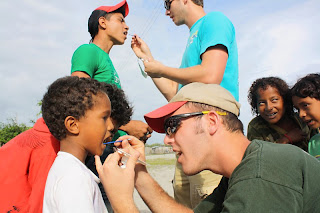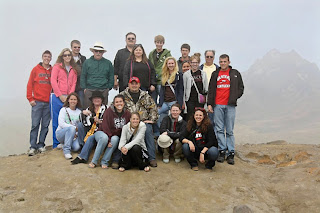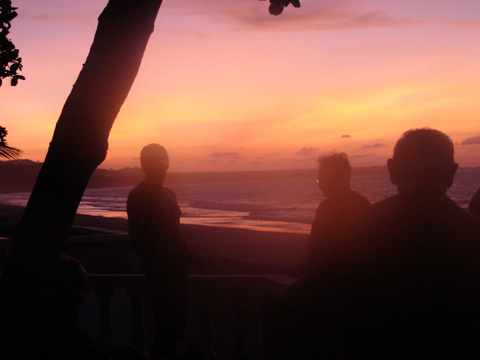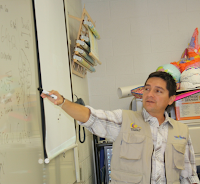
In 1996, while on tour in Ecuador with the rock ‘n roll band Beau Haddock and The Highland Rim, our group ended up in Ambato to headline the Fruit and Flower Festival there. Bands and dance troups from all over the world participate in this annual event. While there, we were invited to a private performance of the local university ballet group. Their dance was choreographed to Pink Floyd’s The Wall. Ruthi commented on how beautiful the girls were, especially the lead dancer.
After the show, we were invited to a reception, where we met the dancers. To our dismay, we noticed that the prima ballerina had a huge cavity in her upper, front tooth, taking so much from her beauty, as well as,I am sure, from her self-esteem. As a dentist, I couldn’t help but realize this lovely, talented young woman would most likely require an extraction within only a few months. Afterwards, Ruthi insisted we had to add a dental component to the volunteer work we had already been doing in Ecuador for nearly ten years.The big question was—-What will we do, and how will we fund it?

For several years, we procrastinated because this would require a huge investment in time and money. In all my prior dental health projects (Haiti, Jamaica, Guatemala, Belize and Ecuador), I was unable to do anything but extractions, and could never come close to meeting the needs of the populace in these communities. It was frustrating to think I was doing nothing more than putting out fires. I came to realize more and more that prevention was the only true help, stopping the decay before it starts. So, in 2002, working directly with the Ecuador Minister of Health, we started a Sealant Project, where we provided the sealant material and training for government dentists in 15 clinics
in Ibarra and several surrounding communities, and 15 clinics in Quito.This was a partnership among the Minister of Health, the government dentists, the schools they supported, the parents, and Kentucky Ecuador Partners. Ruthi and I would provide the sealant material, and the government dentists would place them. The second year, on discovering that these children did not even have toothbrushes, we realized we sort of had the cart before the horse, so provided toothbrushes, which we obtained at a reduced rate from Darby Dental Spencer Meade, a dental supply house from whom we purchase our supplies for our own office.
In order to be successful, we realized we would need several components to this program. The dentists would place the material and every six months, under the pretense of checking to see that the sealants were still in place, they would see the kids back in their offices, clean and check their teeth and add fluoride into the process at the same time. The principals of the schools instituted a daily brushing program and included a dental health education program into their curriculum. Then, both the dentists and the schools began educating the parents. Most of the parents were subsistence farmers, with little or no education ,but loved their children just as we love ours, and wanted to help the kids in whatever ways they could. During the last year of this program, a new product for preventive dentistry entered the market. It was a new fluoride varnish with ACP (Amorphous Calcium Phosphate), manufactured by Premier Dental. This was destined to become one of the best preventive dental materials to ever enter the market. The ACP, when added to the Fluoride Varnish, causes the teeth to absorb 200% more fluoride than a regular fluoride treatment.
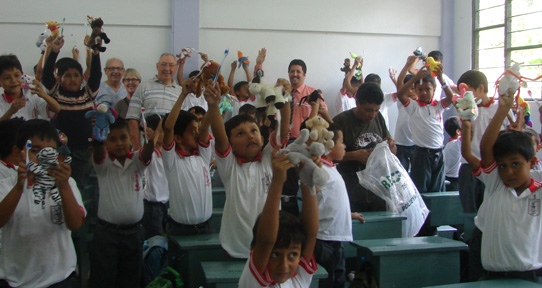
As an added bonus, the ACP remineralizes areas of the teeth which are just beginning to break down. We were soooooo happy to add this material into our preventive arsenal. After this 5-year program, we achieved a reduction in decay of 49%-78%, depending on the clinic responding. During this time, we were able to place 150,000 sealants, and provide toothbrushes to the schools. We were able to bankroll this project ourselves for the most part, because the ACP has other benefits. It is very inexpensive (especially when you get the company to give great discounts, knowing we will promote their company along with the material), and it is very light-weight, which allowed us to simply spread out a few hundred of the applications in our suitcases,shipping the rest with college students coming with Partners, etc. But, sometimes someone, usually one of our patients or sometimes good souls at First Presbyterian Church in Winchester, would just step up and donate a little money or help in some other way. For instance, a charming, cherished and somewhat funny story was about one of those patients and her mother. This patient told her mother up east about what we were trying to do, and both of them became determined to help out. One day, this lady, a Christian in the true sense (the kind the big guy intended that word to be) showed up at our office, telling us that her mother was outside with a gift. We went out to find this woman literally encased in that car with no room for anything but her and the 3,000 toothbrushes she was packing!! We were stunned, asking how and where she came up with all those toothbrushes, then drive them all the way to Kentucky. She simply replied “They’re from New Jersey; don’t ask any questions”. We didn’t.
Our patients Kathy (she with the mom from New Jersey) and Art Sebesta mentioned at one of their six-month check-ups in our office, that they would like to donate toothbrushes to the cause, and we thanked them very much. Three weeks later, we came home for lunch to find the front of our garage door to be covered with toothbrushes, some 25,000 of them! (For all our friends and family always ragging us about the fact our garage has not been cleaned out in years, now you get some small idea why. How can we keep loving, caring people from giving ’til it hurts?) It is hard to write this story without getting choked up just a little. And, the Sebestas are not the only folks who have given what they could, when they could. We have had several people just write a small check, or sometimes just give us some dental or medical supplies they know will be needed in Ecuador, understanding that we will always be good stewards and put every penny or item to good use. May you be blessed, one and all.
Our success in Ecuador led to The Clark County Dental Health Initiative, wherein the Clark County Community Foundation funded a dental health program in the Clark County Kentucky Public School System. We would place the fluoride varnish with ACP on all students, pre-school through 5th grade twice a year. We would then do a dental exam called a DMF survey (Decayed, Missing, Filled), to get an accurate measure of the decay rate in this group. Clark County had an initial decay rate of 50%, appallingly right in line with the rate in the state overall. This places Kentucky in last place in the nation in providing for the dental health of our children. After one year, we were able to realize an 11% decline in the rate of decay. This partnership is between the Winchester Dental Society, the Clark County Health Department, Clark County Community Foundation and the public school system. We are now in year 3 of this 5-year undertaking and are anticipating great success, and an even higher drop in the decay rate.
A note—-This group is also providing a new toothbrush and large tube of toothpaste to all 6,000 students in the Clark County School system.
This brings us to our 2011 dental program in Ecuador. Dr.David Coffey invited us to join his team from Western Kentucky University, including 22 students, to help provide a community service component to their January term Agriculture tour here in Ecuador. In Santo Domingo we trained the students to place the fluoride varnish and also to let them know that they would be leaving something tangible behind, that being hundreds of children whose teeth would be protected against decay for 6 months.
Our first volunteer opportunity was to treat 200 kids in the orphanage Casa Hogar de Jesus. The boys and girls were housed in separate buildings several blocks apart. The experience of working with this team will long be in our minds. The orphans were so grateful and expressed it with smiles, thank yous and big hugs. We went to the girls’ home first and fanned out to begin the applications. Ruthi was working next to a lovely WKU student named Lachelle. A beautiful little girl of perhaps 5 walked directly up to Lachell, looked into her eyes, gave her a winning smile, then wrapped her little arms tightly around her and would NOT let go. Believe us when we say there were tears all around that night when Lachelle had to reluctantly say goodbye. She desperately wanted to adopt the child.These scenes were repeated of course when we went to the boys’ home. These little guys were so adorable. They had already had their baths and were in their jammies when we arrived. We took a lot of photos of some of our guys holding sometimes three little boys in each arm. That is one of the beauties of volunteerism. The volunteers get as much reward as the folks for whom they work.
After we applied the fluoride varnish, all the kids were given toothbrushes. We also placed the varnish on the staff. During the training phase, it seemed quite apparent that the students wanted to do this as quickly as possible and get back to their iPods. But, once they started working, they were so touched by the response of the children that they never wanted the evening to end. Several of them told us this was the highlight of their trip. For many it was the first time they had provided a community service and been given unconditional love in return. The Skinners never tire of this type of work. We know that it is a service with measurable value and that a life of service is always a fulfilling one.(And, come on guys; what a great excuse to get away from the snow, ice and frigid temps of KY in the winter!).
The next day we headed to the city school of Saquisili. By then our team was so professional they had earned the name Los Increibles (The Incredibles). We spent the morning again placing the varnish and giving these kids toothbrushes as well. Several young kids and adults in the neighborhood asked to be treated so of course we did. We headed to lunch with great feelings of accomplishment.
Our next community dental program was in a fishing village deep in the mangroves near the coastal town of Muisne. We rented two dugout canoes with 100 horsepower motors. Leaving the town we blasted through the river, also named Muisne, trailing 5 foot rooster tails of water , half of which seemed to end up in the boat. Our ride through the mangroves was like a trip back in time. Although we were speeding through the mangroves, we were able to see many species of birds and animals in the air and on the banks. We finally arrived at a small isolated fishing village located on a peninsula, the ocean on one side, the river on the other.
As we neared the beach our boat bottomed out, so off came the shoes and we waded ashore. Approaching the tiny village, we came to realize that life here was pretty basic. The houses were wood shacks with tin roofs, and the people were subsistence hunter/gatherers. There were small dugout canoes, but no motors. It was quite obvious that all boat transportation had to be powerd by hand. Hunting, fishing, crabbing, shrimping, small gardens and fruit from the jungle provides all their food needs. The thing which impressed us most was the apparent cohesiveness of this community. They seemed to look out for each other like a close family.
As we entered the village , the children came running to grab our hands and lead us on. All the Spanish speakers in our group (Melissa Stewart, Spanish instructor at WKU, was along on this trip as translator) went from house to house to explain the purpose of our visit. In twenty minutes, everyone in the village had gathered at the community center. Our team began placing the varnish and passing out toothbrushes to all the kids and, as they insisted, we moved on to all the adults. Everybody in this tiny village were treated and their expressions of gratitude touched the hearts of us all. When it came time for us to leave, the people were begging us to stay and at least share a meal. We had to decline as we were losing daylight.
When we headed back, we were surprised to learn that the tide had gone out, and we all waded some 50 yards back to the boats. On the ride back to the town, everyone was quiet, reflecting on how hard some folks’ lives can be and how many blessings we all seem to have. We believe the WKU students’ lives will be forever changed by their participation in this dental program.
Back in Muisne, we trained Rodrigo, a foundation member, to place fluoride varnish and provided enough material for him to treat all the kids in the public schools there. Again, we left with a sense of satisfaction in what we were able to achieve.
After the Western Kentucky students returned to Kentucky on the 21st of January,we, along with Miguel Castanel, headed to Tena and the rainforest to continue our work. We rode a bus from Quito to the town of Pifo, then caught another bus on to Tena. After the thrills and chills of public transport in South America, we arrived safely at our destination. We met with the principal of the public school in Tena and explained our program. The local school dentist volunteered to assist us. The next day we passed out toothbrushes and placed the varnish on all the students in the school. We included pre-schoolers, where a 3-year-old approached Ruthi, threw her arms around her legs, and said “I want you to treat me”. Then Ruthi was rewarded with a big hug and afterward this child followed her around the school like she owned her. We finished the day exhausted, but happy that the children in this community now have six months’ protection against decay. The next day we had a day of rest, and set aside time to challenge the rapids of the Rio Anzu.
Our heartfelt gratitude goes out to Miguel Castanel, who made the arrangements for our entire rainforest activities. For those of you who may not know Miguel. he studied English at U.K., and speaks with a Kentucky accent. He also jumped right in and helped us place the varnish, something he had also done in the Clark County Schools when he was in KY last fall.
Ibarra, Winchester’s Sister City, would be the site of our next dental varnish endeavor. On our trip out of Quito, we drove through a dry, dusty area, then little by little, the lush green hills surrounding Otavalo began changing the scenery entirely. The area around Otavalo has not changed too much in the some 25 years we have been coming to Ecuador, although there is now a 4-lane highway. Many areas still shine through with the lovely site of patchwork gardens showing against the Andes. There are also still charming little farms with the black and white cows, from whom comes the cheese the area is famous for. And, of course the stunning site of Lago San Pablo and Pachamama, the heart of Imbabura. Okay, okay, Ruthi digresses. We’ll get back to that in a later post.
Some 15 miles onward is Ibarra. We rented the only transport we could find, a small farm truck with high walls surrounding the bed. We drove up through the community of Esperanza and continued climbing Imbabura. We finally arrived at the public school, El Abra. The principal of the school says the altitude of this school is 3,800 meters. That translated into 12,467 ft. and believe you me, there ain’t much oxygen to be found. We had to hire a truck because cars will not run at this altitude.
We placed the fluoride varnish on all the kids, only about 70 in this poor mountain village. Then we had the principal bring all the pre-schoolers from another school (at an even higher altitude) to be treated. We have been treating the children at this little school, checking to see if the government dentists were applying the sealants as directed, there being no ACP back then, since 2002. We are seeing very little decay and finally these once-neglected kids are being treated at the government clinics, being treated with fillings, and we’re seeing very few extractions.
One thing we were able to do for these little children which we could do nowhere else, is give them “prizes” for being good patients. Our beloved sister-in-law Roberta is an avid garage sale gal. Ever since we started doing our dental program in Ecuador, she has made a point of going to garage sales in the best neighborhoods in Lexington nearly every week. She seeks out only the best items, such as Beanie Babies, brand new ones still with the tags on them. (One year we were able to send down 300, something which is almost impossible now with the crazy weight restrictions put on by the airlines). Even so, by hook or by crook,enlisting the help and goodwill of some of the other travelers, such as some of the WKU students), we managed to get about 100 beanie babies, several packages of hot wheels, 3 dozen kaleidoscopes from the Skinner dental office, 600 silly band bracelets, etc.
We are, as we said, partial to this little mountain school, so we saved all the beanie babies and hot wheels for these little kids. They jump and squeal with delight over little tokens which so many of our spoiled little Gringo kids might just take for granted. How rewarding it was to us all as we saw their faces light up upon receiving these things. Rankin says he could feel tears starting to well in his eyes as we left, but he was certainly not moved by the kids. It was the altitude. That’s his story, and he’s sticking to it.
Stay tuned for the Kentucky Ecuador Dental Health Initiative, Part 2, coming in a later post.
Rankin Skinner, Ecuador

